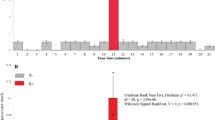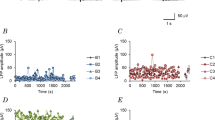Summary
-
1.
Magnetic field stimulation to simulate the rotation of the crayfish statocyst has been performed to determine the response characteristics of the statocyst hair cells. Ferrite grains were introduced about one month before the experiment as a replacement for the natural statoliths to effect magnetic pulling.
-
2.
Several types of response discharge could be recognized. Excitatory response types included tonicon, tonic-on-off, phasic-on, and phasic-on-off types. Inhibitory types can be divided into tonic-inhibition with off-excitation and phasic-inhibition with offinhibition.
-
3.
Statocyst afferent neurons could be classified into several groups depending on the direction of the preferred sensitivity within the simulated rotation plane tested. Among 21 units examined, 9 units showed a single preferred direction with excitatory response and were thus unidirectional units; 3 units were bidirectional, and 5 units were multidirectional. There were 2 bidirectional inhibitory units and 2 multidirectional inhibitory units.
-
4.
Analysis of the response pattern suggests that the central nervous system in the crayfish should be capable of averaging responses of more than one unit among the statocyst afferent neurons to detect the coincidence of discharge frequency change in order to obtain the positional information.
Similar content being viewed by others
References
Cohen, M.J.: The function of receptors in the statocyst of the lobsterHomarus americanus. J. Physiol.130, 9–34 (1955)
Cohen, M.J.: The response patterns of single receptors in the crustacean statocyst. Proc. roy. Soc. Lond. [Biol.]152, 30–48 (1960)
Dijkgraaf, S.: Kompensatorische Augenstieldrehungen und ihre Auslösung bei der Languste (Palinurus vulgaris). Z. vergl. Physiol.38, 491–520 (1956)
Fernandez, C., Goldberg, J.M., Abend, W.K.: Response to static tilts of peripheral neurons innervating otolith organs of the squirrel monkey. J. Neurophysiol.35, 978–997 (1972)
Hisada, M.: Structural and functional polarization of the statocyst hairs of crayfish. J. Physiol. Soc. Japan37, 292 (1975a) [In Japanese]
Hisada, M.: Gravitational and visual control of eye movement in crayfish. Fortschr. Zool.23, 162–173 (1975b)
Hisada, M., Sugawara, K., Higuchi, T.: Visual and geotactic control of compensatory eyecup movement in the crayfishProcambarus clarki. J. Fac. Sci. Hokkaido Univ. Ser. VI, Zool.17, 224–239 (1969)
Kinzig, H.: Untersuchungen über den Bau der Statocysten einiger dekapoden Crustaceen. Verhandl. Naturhist.-med. Ver. Heidelberg N.F.14, 1–19 (1919)
Kreidl, A.: Weitere Beiträge zur Physiologie des Ohrlabyrinthes. II. Versuche an Krebsen. S.-B. Akad. Wiss. Wien, math.-nat. Kl.102, 149–174 (1893)
Ozeki, M.: The effects of eugenol on the nerve and muscle in crayfish. Comp. Biochem. Physiol.50 C, 183–191 (1975)
Ozeki, M., Osada, S.: Upside-down orientation in the crayfish with ferrite statoliths during magnetic field stimulation, (in preparation)
Patton, M.L.: Physiological evidence indicating that decapod statocyst hairs drive three sensory neurons. Amer. Zool.9, 1097 (1969)
Prentiss, C.W.: The otocyst of decapod crustacea. Bull. Mus. Comp. Zool. Harvard36, 167–254 (1901)
Sandeman, D.C., Okajima, A.: Statocyst-induced eye movements in the crabScylla serrata. I. The sensory input from the statocyst. J. exp. Biol.57, 187–204 (1972)
Schöne, H.: Die statische Gleichgewichtsorientierung dekapoder Crustaceen. Verh. dtsch. zool. Ges.16, 157–162 (1951a)
Schöne, H.: Die Arbeitsweise der Statocyste vonAstacus fluviatilis. Naturwissenschaften38, 157 (1951b)
Schöne, H.: Statocystenfunktion und statische Lageorientierung bei dekapoden Krebsen. Z. vergl. Physiol.36, 241–260 (1954)
Schöne, H., Steinbrecht, R.A.: Fine structure of statocyst receptor ofAstacus fluviatilis. Nature (London)220, 184–186 (1968)
Stein, A.: Attainment of positional information in the crayfish statocyst. Fortschr. Zool.23, 109–117 (1975)
Vidal, J., Jeannerod, M., Lifschitz, H., Rosenberg, J., Segundo, J.P.: Static and dynamic properties of gravity-sensitive receptors in the cat vestibular system. Kybernetik9, 205–215 (1971)
Wilkens, L.A., Wolfe, G.E.: A new electrode design foren passant recording, stimulation and intracellular dye injection. Comp. Biochem. Physiol.48, 217–220 (1974)
Author information
Authors and Affiliations
Additional information
This paper is dedicated to the memory of the late Professor Mituo Tamasige of the Zoological Institute, Faculty of Science, Hokkaido University.
Dr. Ozeki is a visiting research fellow supported by a grant from the Japan Society for the Promotion of Science. This study was also partially supported by the Takeda Science Foundation.
Rights and permissions
About this article
Cite this article
Ozeki, M., Takahata, M. & Hisada, M. Afferent response patterns of the crayfish statocyst with ferrite grain statolith to magnetic field stimulation. J. Comp. Physiol. 123, 1–10 (1978). https://doi.org/10.1007/BF00657338
Accepted:
Issue Date:
DOI: https://doi.org/10.1007/BF00657338




